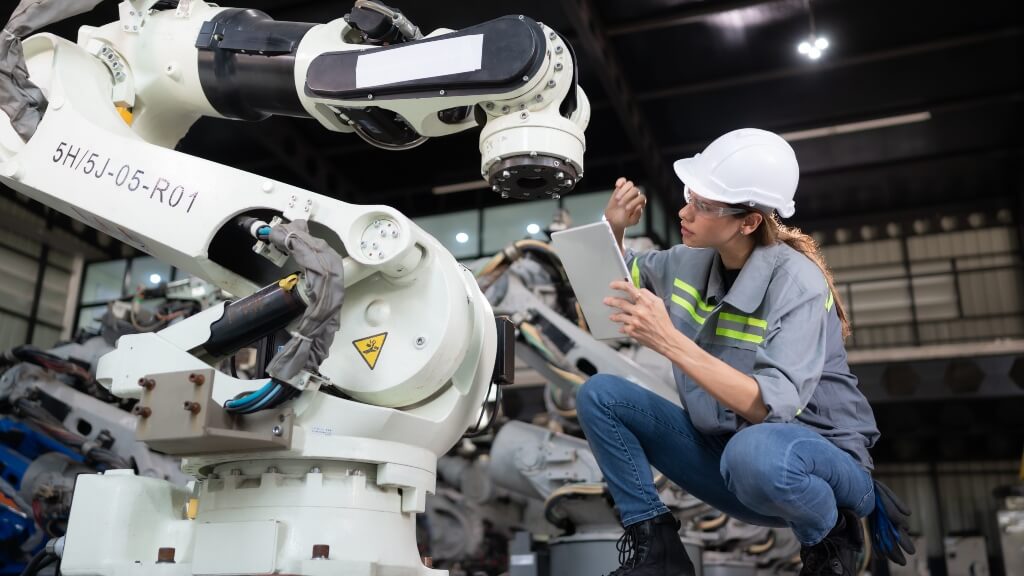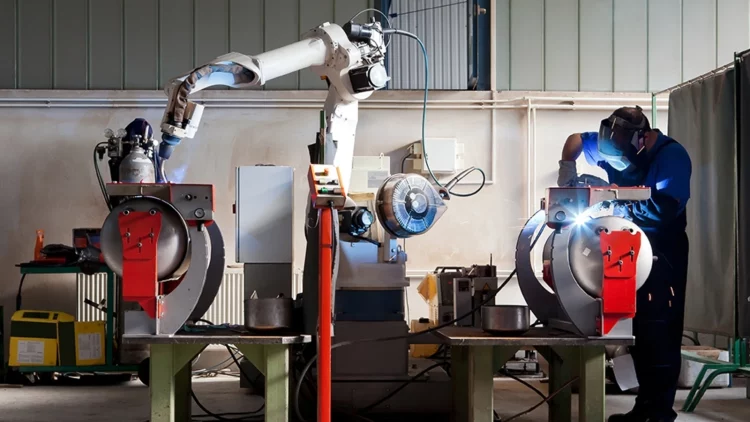Introduction: The Rise of the Robotics Industry
The rapid advancements in robotics technology have set the stage for an extraordinary transformation across industries. In just a few decades, robots have evolved from simple automation tools to complex, autonomous machines capable of performing highly sophisticated tasks. Today, the robotics industry is on the verge of a monumental growth trajectory, with projections indicating that the global market could reach a trillion-dollar scale in the near future.
From manufacturing and healthcare to agriculture and space exploration, robotics is already making a significant impact. The integration of artificial intelligence (AI), machine learning (ML), and cloud computing has enhanced the capabilities of robots, allowing them to become increasingly intelligent, adaptable, and capable of working alongside humans. These advances are driving a new wave of innovation, creating a perfect storm for growth in the robotics sector.
In this article, we will explore the factors that are fueling the expansion of the robotics industry, the market segments poised for growth, and the opportunities and challenges that lie ahead. We will also discuss the role of key technologies in shaping the future of robotics and examine how the industry is positioning itself for a future worth trillions of dollars.
1. The Global Robotics Market: Key Drivers of Growth
The growth of the robotics industry is underpinned by several key factors, including advancements in technology, increasing demand for automation, and the need for solutions to address global challenges.
1.1. Technological Advancements
The robotics industry has benefited immensely from developments in AI, machine vision, sensor technologies, and robotic autonomy. These innovations are allowing robots to perform tasks that were previously unthinkable, such as real-time decision-making, navigating dynamic environments, and learning from their experiences.
- Artificial Intelligence and Machine Learning: AI and ML algorithms enable robots to make decisions autonomously, adapting to their environment and optimizing performance. As robots become smarter, they can perform more complex tasks, extending their reach into areas previously dominated by human workers.
- Advanced Sensors and Perception: The development of more sophisticated sensors, such as LiDAR, infrared cameras, and pressure sensors, has greatly enhanced a robot’s ability to perceive and interact with its surroundings. This technological leap is a crucial driver for sectors like healthcare, where robots can assist in delicate surgeries with high precision.
- Collaborative Robots (Cobots): The rise of collaborative robots, which can safely work alongside human operators in shared environments, has created a whole new market within the industrial robotics sector. Cobots are already being used in industries such as manufacturing, logistics, and food production, and their demand is expected to grow exponentially in the coming years.
1.2. Rising Demand for Automation
Automation has become essential in a variety of industries, as businesses seek to improve efficiency, reduce costs, and increase productivity. Robotics plays a pivotal role in this transition, especially in sectors such as manufacturing, logistics, and healthcare.
- Manufacturing: The move towards Industry 4.0, characterized by the integration of automation, IoT (Internet of Things), and AI, is driving the growth of robotics in manufacturing. Automated systems are capable of performing repetitive and complex tasks with greater speed and precision than human workers.
- Logistics and Supply Chain: Robotics is revolutionizing the logistics sector, with applications in warehouse automation, inventory management, and delivery systems. Autonomous robots and drones are increasingly being used to move goods within warehouses and deliver packages directly to consumers.
- Healthcare: The demand for robots in healthcare continues to increase, particularly in the form of surgical robots, rehabilitation robots, and disinfection robots. Robots are helping medical professionals perform complex surgeries with greater accuracy, assist patients in their rehabilitation, and improve the quality of healthcare delivery.
1.3. Aging Populations and Labor Shortages
In many parts of the world, especially in developed countries, aging populations and labor shortages are becoming significant issues. With fewer young people entering the workforce, there is an increasing reliance on automation and robotics to fill the gaps.
- Elder Care and Assistance: Robotics technologies are emerging as a solution to provide assistance and care for elderly individuals. Robots can assist with daily activities, monitor health conditions, and even provide companionship, alleviating the pressure on caregivers.
- Labor Shortages in Critical Industries: Many industries, including agriculture, manufacturing, and healthcare, face labor shortages. Robotics is helping to fill this void, with robots taking on jobs that are either too dangerous, repetitive, or difficult for human workers.
2. Robotics Industry Segments: Areas Poised for Exponential Growth
The robotics industry is vast, and several market segments are expected to experience rapid growth in the coming years. These sectors include manufacturing, healthcare, logistics, agriculture, and consumer robotics.
2.1. Industrial Robotics
Industrial robotics has been the backbone of the robotics industry for decades, and its growth is set to continue, driven by automation and smart manufacturing.
- Smart Manufacturing: As factories become increasingly automated, robots will play a central role in enabling flexible manufacturing systems. Robots equipped with AI and machine learning will allow manufacturers to adapt to changing production demands and customize products on the fly.
- Robotic Process Automation (RPA): RPA is an emerging technology that uses robots to automate office tasks such as data entry, document management, and customer service. This will expand the role of robots beyond physical labor to intellectual tasks.
2.2. Healthcare Robotics
The healthcare sector is experiencing a boom in robotics applications. As the demand for healthcare services continues to rise, robots are becoming essential tools in the surgical, rehabilitation, and diagnostic fields.
- Surgical Robots: Robots like Da Vinci Surgical System allow surgeons to perform minimally invasive procedures with unparalleled precision. These systems can perform delicate operations, such as prostatectomies or heart surgeries, with greater accuracy and fewer complications.
- Robotic Prosthetics and Exoskeletons: Advances in robotic prosthetics are giving patients greater mobility and freedom. Exoskeletons are being developed to assist individuals with paralysis or mobility impairments, offering new hope for rehabilitation.
- Disinfection Robots: The COVID-19 pandemic has accelerated the adoption of disinfection robots, which use ultraviolet light to sterilize hospital rooms, improving infection control measures and reducing the risk of contamination.
2.3. Logistics and Supply Chain Robotics
Logistics and supply chain automation is another area where robotics is experiencing rapid growth. As e-commerce continues to surge, there is an increased demand for faster, more efficient fulfillment and delivery systems.
- Warehouse Robots: Autonomous mobile robots (AMRs) are transforming warehouse operations by automating tasks such as inventory management, order picking, and package sorting. These robots improve speed and reduce the risk of human error.
- Delivery Drones and Autonomous Vehicles: Autonomous drones and vehicles are beginning to take over last-mile deliveries, a critical part of the logistics chain. These systems are not only faster but also more cost-effective, offering huge potential for cost savings in logistics.
2.4. Consumer Robotics
Consumer robots, such as robotic vacuum cleaners and personal assistant robots, are gaining traction as consumers seek to simplify daily tasks and improve home convenience.
- Personal Assistant Robots: Robots that can assist with everyday tasks like cleaning, cooking, or even providing companionship are expected to be in high demand. With advancements in AI, these robots will be capable of learning the preferences of their owners and adapting to their needs over time.
- Home Healthcare Robots: With the aging population and increasing healthcare needs, home healthcare robots that monitor health metrics, administer medication, and provide remote medical consultations are gaining attention.

3. Key Technologies Driving the Future of Robotics
Several technologies are acting as enablers for the growth of the robotics industry. These include AI, 5G, machine learning, and advanced materials.
3.1. Artificial Intelligence (AI) and Machine Learning
AI algorithms are enabling robots to perform tasks autonomously, make decisions in real-time, and continuously improve their performance through reinforcement learning. AI-powered robots are capable of interacting with their environment and adapting their behavior, making them much more efficient and versatile than traditional robots.
3.2. 5G Connectivity
The implementation of 5G networks will enable robots to operate in real-time, exchanging data faster and more securely. This is particularly important for swarm robotics, remote surgery, and autonomous vehicles, where real-time data exchange is essential for performance and safety.
3.3. Advanced Materials and Manufacturing Techniques
Innovations in materials science are leading to the development of lighter, stronger, and more flexible robots. 3D printing allows for the rapid prototyping and customization of robotic parts, making it easier to design robots for specific tasks and reducing production costs.
4. Challenges and Opportunities for the Robotics Market
While the growth of the robotics industry presents vast opportunities, there are also challenges to address.
4.1. Challenges
- Regulation and Ethics: As robots become more autonomous, regulatory frameworks and ethical guidelines need to be developed to ensure safety and accountability.
- Job Displacement: The widespread adoption of robotics could lead to job displacement in certain sectors. However, it is also expected to create new opportunities in tech, engineering, and robotics-related fields.
4.2. Opportunities
- Global Expansion: Robotics is seeing increasing adoption in emerging markets, particularly in Asia-Pacific and Latin America, where labor costs are rising, and automation offers an effective solution.
- Sustainability: Robots have the potential to help tackle global challenges, such as climate change, by improving energy efficiency, reducing waste, and enhancing resource management.
Conclusion: A Trillion-Dollar Future
The future of the robotics industry looks bright, with the market expected to reach a trillion-dollar scale. Advancements in AI, automation, and robotics hardware are transforming industries worldwide, creating new opportunities for growth. As technology continues to evolve, robots will become increasingly autonomous, intelligent, and integrated into everyday life. The road to a trillion-dollar robotics market is paved with both opportunities and challenges, but with continued investment and innovation, the future is promising.







































